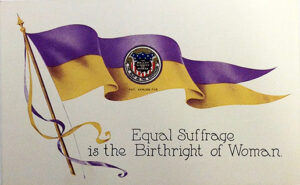
The month of March has eleven awareness celebrations. Some may seem slightly silly, like National Celery Month, established in 2015; others, like Irish American Heritage Month established in 1995, celebrate American diversity.*
The designation I find most meaningful is WOMEN’S HISTORY MONTH.
I ‘m dating myself when I share that when I was growing up, the only women mentioned in my history classes were Betsey Ross, credited with sewing the first American flag; the abolitionist Grimke Sisters; and Harriet Tubman and her work with the Underground Railroad. Over in English class, there were the Bronte sisters; Emily Dickenson; and George Eliot. And that was about it. No woman ran for president. No woman became an astronaut.
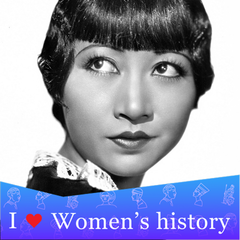
There are, of course, thousands of women who made a significant impact on all aspects of modern life, but they were largely unknown and invisible. Today, thanks in large part to Women’s History Month, women’s contributions are recognized as part of the tapestry of modern life.
In 1978 educators in Santa Rosa, California built a Women’s History Week of celebrations around International Women’s Day on March 8. Two years later, President Jimmy Carter issued a presidential proclamation declaring March 2-8 as Women’s History Week. In 1987 Congress designated the entire month of March as Women’s History Month.
Women’s Colors
Since the early 20th century, three colors have been associated with women’s history.
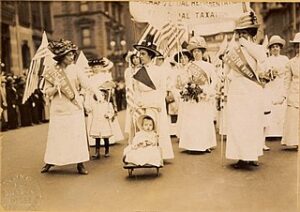
Green: the color representing hope, new beginnings, and growth
Purple: the color representing justice, dignity, and visionary thinking
White: the color of purity and equality.
In the early twentieth century when opponents of women’s right to vote portrayed suffragists as immoral, advocates embraced the color white. White emphasized the purity of women’s cause, and the sight of women wearing white while marching through the streets drew people’s attention.
Women’s History Profile: Jeannette Rankin
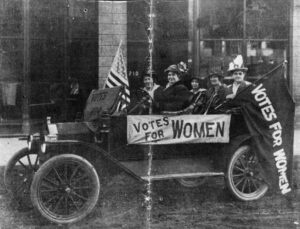
In 1914 Montana granted women the right to vote. Three years later, Jeannette Rankin (1880-1973) became the first woman elected to Congress. It would be another four years before the 19th Amendment to the Constitution granted all American women the right to vote. Rankin was a Republican and ran on the platform of woman suffrage and social welfare reform. In 1917, as the United States drew closer to entering what became known as World War I, Rankin pledged that she would not vote for American involvement.
Imagine the consternation in Congress when Rankin arrived to take her seat. Congress debated for a month before seating the woman elected in 1916. She was sworn in on April 2, 1917. [At that time, elections occurred in November, but the change in government occurred the following March.]
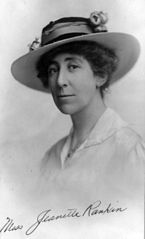
As Rankin took her seat in Congress, President Woodrow Wilson addressed Congress to urge a declaration of war against Germany and her allies. Rankin told her colleagues: “I want to stand by my country, but I cannot vote for war.” The vote took place three days later. The resolution for a declaration of war passed 373 to 50. Male members of Congress cast forty-nine of the negative votes. As concerns about war swept the country, nay sayers were attacked. The New York Times commented, “Miss Rankin’s vote is regarded, not as that of a pacifist, but rather as one dictated by the inherent abhorrence of women for war.”
As the year 1917 moved forward, Rankin led an effort to create a Committee of Woman Suffrage in Congress and worked to create a constitutional amendment extending suffrage to women across the country. The effort died in the Senate.
At the end of her term, Rankin returned to Montana and was not re-elected. In 1940, Rankin was elected to a second term in Congress. In December 1941, Japan attacked Pearl Harbor. Once again, Rankin cast her vote against a declaration of war.
Women’s History Profile: Anna May Wong
Rankin’s contemporary Anna May Wong (1905-1961) made her screen debut in The Red Lantern in the uncredited role of “Lantern Bearer.” By 1924, she was an international star and fashion icon. She was also a victim of American racism, particularly anti-Chinese sentiment. Undeterred, Wong continued her career. In 1951 she led the cast of television’s The Gallery of Madam Liu-Tsong. She received a star on the Hollywood Walk of Fame in 1960. In 2022 the U.S. Mint issued the Anna May Wong Quarter, the fifth quarter in the American Women Quarters Program.
The video below contains clips of Anna May Wong’s work (9 minutes)
🧕🏽 👩🏻⚖️ 🤱 👩🏽💻 👩🏿🎤
*Full list of March monthly celebrations: Music in our Schools Month; National Celery Month; Craft Month; Frozen Food Month; Irish American Heritage Month; National Nutrition Month; Peanut Month; Red Cross Month; Social Workers Month; Women’s History Month
Illustrations & A Few Sources
Equal Suffrage Is the Birthright of Women, 1910 Postcard; Anna May Wong; 1912 New York City Suffragist Parade; 1914 Montana Suffragists by Suffrage Daily News; Jeannette Rankin. “On This Day: Jeannette Rankin’s History-Making Moment.” National Constitution Center. April 2, 2023; Kerri Lee Alexander. “Anna May Wong.” National Women’s History Museum; Perri Ormont Blumbert. “Women’s History Month Colors.” Today. Feb 7, 2023.
Sandra’s Books: Ambition, Arrogance & Pride. Saxon Heroines. Two Coins. Rama’s Labyrinth.

Sandra Wagner-Wright holds the doctoral degree in history and taught women’s and global history at the University of Hawai`i. Sandra travels for her research, most recently to Salem, Massachusetts, the setting of her new Salem Stories series. She also enjoys traveling for new experiences. Recent trips include Antarctica and a river cruise on the Rhine from Amsterdam to Basel.
Sandra particularly likes writing about strong women who make a difference. She lives in Hilo, Hawai`i with her family and writes a blog relating to history, travel, and the idiosyncrasies of life.

